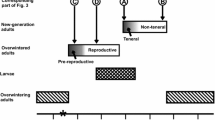Abstract
Beetles were milked of their abdominal defensive secretion at three different frequencies over the first 36 days of adult life. Secretion production decreased greatly with age from a maximum of 94 nmol/day at 4–6 days to a basal level of about 25 nmol/day at 30–40 days. Ethyl- and methylquinone comprised the bulk of the secretion and were most strongly affected by age. Benzoquinone was most strongly affected by milking frequency. An average adult produced an estimated 4445 nmol of total secretion in its 5-month life-span but had reservoirs large enough to store 11,000 nmol. Males produced more secretion than females because of their larger size and inherent sexual differences. As they aged, mated females showed a more rapid decrease in production that virgin females. The defensive system appears to be programed to charge glands rapidly with secretion early in adult life and fall of to a low recharge rate little affected by discharge.
Similar content being viewed by others
References
Blum, M.S. 1981. Chemical Defenses of Arthropods. Academic Press, New York, 562 pp.
Carrel, J.E. 1984. Defensive secretion of the pill millipedeGlomeris marginata. I. Fluid production and storage.J. Chem. Ecol. 10:41–51.
Classen, R., andDettner, K. 1983. Pygidial defensive titer and population structure ofAgabus paludosus F. (Coleoptera, Dytiscidae).J. Chem. Ecol. 9:201–209.
Dettner, K. 1979. Chemotaxonomy of water beetles based on their pygidial gland constituents.Biochem. Syst. Ecol. 7:129–140.
Dettner, K., andSchwinger, G. 1982. Defensive secretions of three Oxytelinae rove beetles (Coleoptera: Staphylinidae).J. Chem. Ecol. 8:1411–1420.
Eisner, T. 1958. The protective role of the spray mechanism of the bombardier beetle,Brachynus ballistarius Lee.J. Insect Physiol. 2:215–220.
Eisner, T., andMeinwald, J. 1966. Defensive secretions of arthropods.Science 184:996–999.
Engelman, F. 1970. The Physiology of Insect Reproduction. Pergamon Press, New York, 307 pp.
Fescemeyer, H.W., andMumma, R.O. 1983. Regeneration and biosynthesis of dytiscid defensive agents (Coleoptera: Dytiscidae).J. Chem. Ecol. 9:1449–1464.
Jacobson M. 1966. Chemical insect attractants and repellents.Annu. Rev. Entomol. 11:403–422.
Kaneshisa, K. 1978. Comparative study of the abdominal defensive systems in tenebrionid beetles.Ber. Ohara Inst. Landwirtsch. Biol. Ohayama Univ. Bd. 17(2):47–55.
Meinwald, J., Prestwich, G.D., Nakanishi, K., andKubo, I. 1978. Chemical ecology: Studies from East Africa.Science 199:1167–1173.
Miller, J., andMumma, R.O. 1974. Seasonal quantification of the defensive steroid titer ofAgabus seriatus (Coleoptera: Dytiscidae).Ann. Entomol. Soc. Am. 67(6):850–852.
Newhart, A.T., andMumma, R.O. 1978. High-pressure liquid Chromatographic techniques for the separation and quantification of norsequiterpenes from gyrinids.J. Chem. Ecol. 4:503–510.
Newhart, A.T., andMumma, R.O. 1979a. Defensive secretions of three species ofAcilius (Coleoptera: Dytiscidae) and their seasonal variations as determined by high-pressure liquid chromatography. J. Chem. Ecol. 5:643–652.
Newhart, A.T., andMumma, R.O. 1979b. Seasonal quantification of the defensive secretions from Gyrinidae.Ann. Entomol. Soc. Am. 72:427–429.
Rockstein, M. (ed). 1978. Biochemistry of Insects. Academic Press, New York, 649 pp.
Roth, L.M., andEisner, T. 1962. Chemical defenses of arthropods.Annu. Rev. Entomol. 7:107–136.
Schildknecht, H. 1971. Evolutionary peaks in the defensive chemistry of insects.Endeavor 30:136–141.
Tschinkel, W.R. 1969. Phenols and quinones from the defensive secretions of the tenebrionid beetle.Zophobas rugipes.J. Insect Physiol. 15:191–200.
Tschinkel, W.R. 1975. A comparative study of the chemical defensive system of tenebrinoid beetles. I. Chemistry of the secretion.J. Insect Physiol. 21:753–783.
Author information
Authors and Affiliations
Rights and permissions
About this article
Cite this article
Hill, C.S., Tschinkel, W.R. Defensive secretion production in the tenebrionid beetle,Zophobas atratus . J Chem Ecol 11, 1083–1092 (1985). https://doi.org/10.1007/BF01020677
Received:
Accepted:
Issue Date:
DOI: https://doi.org/10.1007/BF01020677




